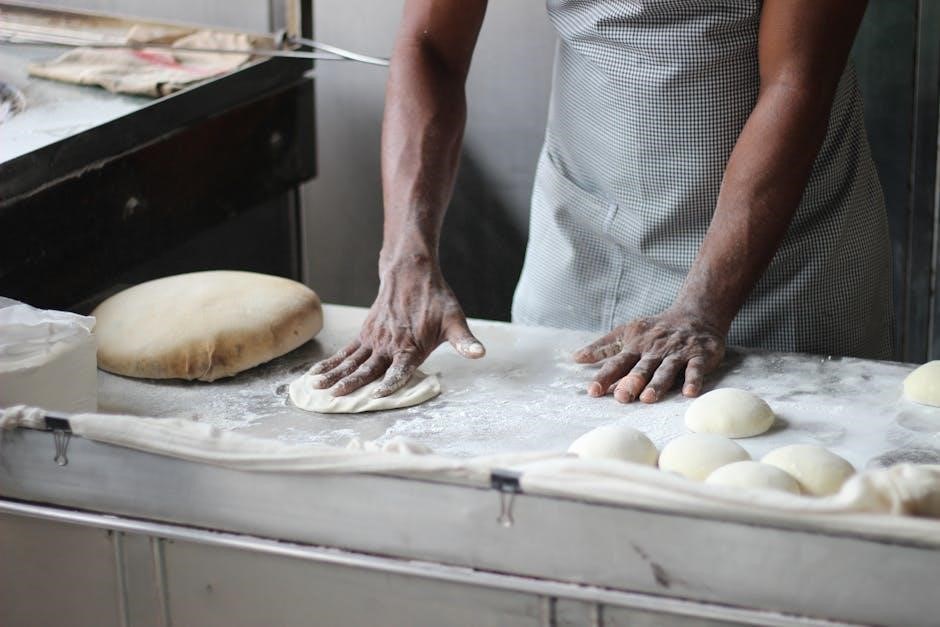Oster Bread Maker Recipes PDF: A Comprehensive Guide
Unlock the full potential of your Oster bread maker with our comprehensive guide. Discover a treasure trove of recipes conveniently available in PDF format. From classic loaves to sweet treats‚ master the art of homemade bread.

Understanding Oster Bread Maker Models
Delving into the world of Oster bread makers requires understanding the nuances between different models. Oster offers a range of bread makers‚ each with unique features and capabilities. Some models‚ like the Oster ExpressBake series (including models such as 5836 and 5838)‚ prioritize speed‚ offering an “ExpressBake” setting for quicker bread preparation. These models may have limitations regarding specialized dough or sweet bread settings.
Other Oster bread maker models‚ such as the Deluxe Bread & Dough Maker (e.g.‚ model 5844)‚ offer more versatility with multiple settings and even memory locations for storing personalized recipes. Understanding these distinctions is crucial for selecting the appropriate recipes and settings.
For instance‚ some models may lack a dedicated setting for quick breads like banana bread. It’s essential to consult your specific Oster bread maker manual (often available as a PDF download) to understand the available settings and their optimal uses. This ensures successful bread-making outcomes and prevents frustration from mismatched recipe requirements. Furthermore‚ knowing your model helps in troubleshooting and adapting recipes for the best results.
Finding the Right Oster Bread Maker Manual PDF
Locating the correct Oster bread maker manual in PDF format is essential for successful bread making. The manual serves as a comprehensive guide‚ providing model-specific instructions‚ safety precautions‚ and‚ crucially‚ recommended recipes and settings.
Begin your search by identifying the exact model number of your Oster bread maker; This is typically found on a sticker located on the appliance’s base or back. Once you have the model number‚ use it to search online. Add terms like “Oster bread maker manual PDF” or “Oster [model number] manual PDF” to your search query.
Oster’s official website is a primary source for manuals. Many appliance-related websites and online libraries also host PDF versions of Oster bread maker manuals. Be cautious when downloading from third-party sites‚ ensuring they are reputable to avoid malware.
The manual will detail the specific settings available on your machine‚ including the ExpressBake setting (if applicable)‚ dough settings‚ and options for different loaf sizes. It also provides troubleshooting tips for common issues. Having the correct manual ensures you’re using the appliance safely and effectively.
Essential Recipes for Oster Bread Makers
Mastering a few essential recipes is key to unlocking the full potential of your Oster bread maker. Begin with a classic white bread recipe‚ a staple that serves as a foundation for sandwiches and toast. Experiment with whole wheat variations for a healthier option‚ adjusting the liquid content as needed to accommodate the denser flour.
For those seeking a quicker option‚ explore recipes designed for the ExpressBake setting‚ remembering that bread machine flour often yields the best results. Don’t overlook the versatility of dough-making cycles; use your Oster bread maker to prepare pizza dough or rolls‚ allowing it to handle the kneading process effortlessly.
Sweet bread recipes‚ such as cinnamon raisin bread or banana bread‚ offer delightful treats. Be aware that some Oster models may not have a dedicated sweet bread setting‚ requiring adjustments to baking times and temperatures.
Always follow recipe instructions carefully‚ paying attention to the order in which ingredients are added. Accurate measurements are crucial for consistent results.
ExpressBake Setting Recipes
The ExpressBake setting on your Oster bread maker offers a fantastic way to enjoy freshly baked bread in under an hour. However‚ achieving optimal results requires specific recipes and techniques. These recipes are specially formulated to work with the rapid rise and bake times of this setting.
It’s crucial to use bread machine flour for ExpressBake recipes‚ as it contains higher gluten levels necessary for quick development. Ensure that the ingredients are at room temperature for faster activation. Precise measurements are even more critical than usual‚ so use measuring tools.
Consider that the texture might differ slightly from traditionally baked bread; it may be denser. Don’t be afraid to experiment with small adjustments to the liquid or yeast to achieve your desired outcome.
Remember that the ExpressBake setting is designed for simpler bread recipes. Avoid recipes with heavy add-ins like nuts or dried fruits‚ as they may not distribute evenly or bake properly in the short time frame. Embrace the speed and convenience of ExpressBake for those moments when you crave fresh bread in a hurry.

Troubleshooting Common Issues
Even with the best recipes‚ bread makers can sometimes present challenges. If your loaf isn’t rising‚ ensure your yeast is fresh and properly activated. Check the expiration date and test it with a bit of warm water and sugar before adding it to the bread machine.
A collapsed loaf might indicate too much liquid; reduce the liquid slightly in your next attempt. Conversely‚ a dry‚ crumbly loaf suggests not enough liquid; add a tablespoon at a time until the dough consistency improves.
If the paddle gets stuck‚ make sure you’re using the correct paddle for your Oster model and that it’s properly installed. Occasionally‚ the paddle may come loose during kneading; pausing the machine and re-securing it can help.
Uneven baking can result from incorrect ingredient layering or a faulty heating element. Ensure you follow the recipe’s layering instructions and contact Oster support if the issue persists.
Lastly‚ a burning smell may indicate spilled ingredients or an overheated machine. Unplug the bread maker immediately and allow it to cool before inspecting and cleaning it thoroughly. Addressing these common issues proactively ensures consistently delicious results.
Tips for Perfect Bread Every Time
Achieving consistently perfect bread from your Oster bread maker involves a few key techniques. Always use fresh‚ high-quality ingredients‚ especially bread flour‚ which has a higher gluten content for better structure. Measure ingredients accurately using measuring cups and spoons designed for baking.
The order in which you add ingredients matters. Typically‚ liquids go in first‚ followed by dry ingredients‚ with yeast added last‚ often in a well on top of the flour. This prevents premature activation.
Monitor the dough during the kneading process. It should form a smooth‚ elastic ball. If it’s too sticky‚ add a little flour; if it’s too dry‚ add a little water. Adjustments are crucial for optimal texture.
Consider the room temperature. Cold environments can slow down rising‚ while warm environments can accelerate it. Adjust the yeast amount accordingly.
For enhanced flavor‚ experiment with additions like herbs‚ seeds‚ or dried fruits. Add these during the kneading cycle‚ following your recipe’s instructions.
Finally‚ let the bread cool completely before slicing to prevent it from becoming gummy. Use a serrated bread knife for clean‚ even slices. These tips will elevate your bread-making game.

Adapting Recipes for Different Loaf Sizes
Successfully adapting bread recipes for varying loaf sizes in your Oster bread maker is a valuable skill. Begin by understanding your machine’s loaf capacity‚ usually specified in pounds (e.g.‚ 1.5lb‚ 2lb). If a recipe is for a 2lb loaf and you want a 1lb loaf‚ you’ll need to scale down the ingredients.
The simplest method is to calculate the ratio between the desired loaf size and the original loaf size (e.g.‚ 1lb / 2lb = 0.5). Then‚ multiply each ingredient quantity by this ratio. For example‚ if the original recipe calls for 4 cups of flour‚ you’d use 2 cups (4 cups x 0.5).
However‚ be cautious when scaling down yeast. Reducing it proportionally can sometimes hinder the rise. A slight adjustment might be necessary‚ especially in colder climates.
Also‚ remember that smaller loaves may bake faster. Monitor the baking process and reduce the baking time if needed to prevent over-browning. Use a cooking thermometer to ensure the internal temperature reaches the recommended level.
Finally‚ keep a record of your adjustments and results. This will help you refine your scaling techniques and consistently achieve the perfect loaf size.
Using Bread Machine Flour

Understanding the role of flour is crucial for successful bread making‚ especially when using an Oster bread machine. Bread machine flour‚ often labeled as such‚ is specifically formulated to enhance bread machine performance. Its key characteristic is a higher protein content compared to all-purpose flour. This increased protein‚ primarily gluten‚ contributes to a stronger gluten network‚ resulting in improved dough elasticity and rise.
When using bread machine flour in your Oster‚ expect a lighter‚ airier loaf with a more consistent texture. While all-purpose flour can be used‚ the results might not be as predictable‚ particularly for recipes requiring a significant rise.
For the ExpressBake setting‚ using bread machine flour is generally recommended. This setting relies on rapid yeast activity and gluten development‚ which bread machine flour facilitates.
If bread machine flour isn’t available‚ you can enhance all-purpose flour by adding vital wheat gluten. A general guideline is to add about 1 to 2 tablespoons of vital wheat gluten per cup of all-purpose flour.
Experimenting with different flour types can lead to interesting variations in taste and texture. However‚ for consistent results‚ especially with standard recipes‚ bread machine flour is a reliable choice for your Oster bread maker.
Sweet Bread and Quick Bread Recipes
Beyond traditional loaves‚ your Oster bread maker is also capable of creating delectable sweet breads and quick breads. However‚ it’s important to understand the nuances of these recipes to ensure optimal results.
Sweet breads‚ such as cinnamon raisin bread or chocolate chip bread‚ typically incorporate ingredients like sugar‚ butter‚ eggs‚ and sometimes even cream cheese‚ resulting in a richer‚ more tender crumb. When adapting sweet bread recipes for your Oster‚ be mindful of the sugar content. Excessive sugar can sometimes interfere with yeast activity.
Quick breads‚ on the other hand‚ rely on chemical leavening agents like baking powder or baking soda instead of yeast. Banana bread‚ zucchini bread‚ and cornbread are popular examples. Ensure your Oster model has a specific “Quick Bread” setting. If not‚ a “Cake” setting might work as an alternative‚ though some models are designed for yeast-based doughs and might not be suitable for quick breads.
For both sweet and quick breads‚ carefully measure ingredients and add them in the order specified in the recipe. Overmixing can lead to tough quick breads‚ so avoid prolonged kneading cycles. Always consult your Oster manual or recipe book for recommended settings and cycle times for these types of breads.
Cleaning and Maintaining Your Oster Bread Maker
Proper cleaning and maintenance are crucial for extending the life of your Oster bread maker and ensuring consistently delicious results. After each use‚ unplug the bread maker and allow it to cool completely before cleaning. The bread pan is usually non-stick‚ so gently remove any remaining bread crumbs with a soft cloth or sponge. Avoid using abrasive cleaners or scouring pads‚ as these can damage the non-stick coating.
Wash the bread pan and kneading blade with warm‚ soapy water. Ensure all dough residue is removed. Some models have dishwasher-safe parts‚ but always consult your Oster manual. Wipe down the exterior of the bread maker with a damp cloth; Never immerse the bread maker in water or any other liquid.
Occasionally‚ the heating element might require cleaning. Use a soft‚ dry cloth to gently wipe away any spills or food debris. Avoid using water or cleaning solutions on the heating element. Check the kneading blade for wear and tear‚ and replace it if necessary. Store your Oster bread maker in a cool‚ dry place when not in use. Regular cleaning and maintenance will keep your bread maker in optimal condition.


